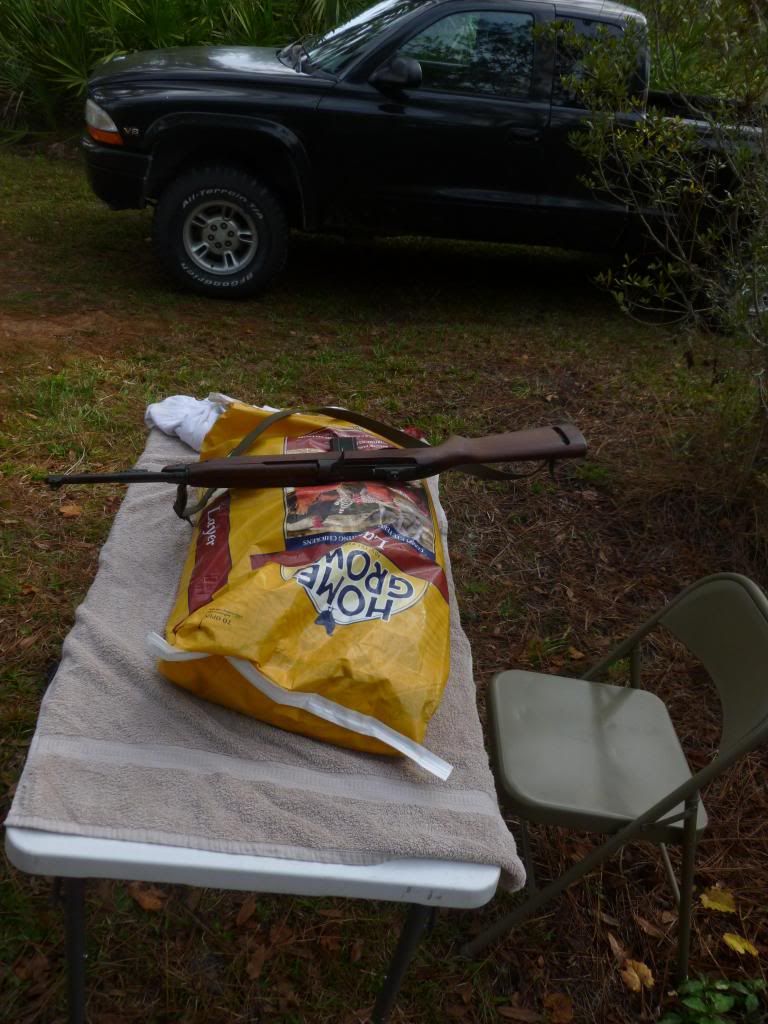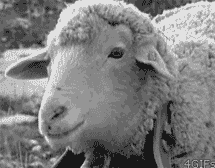Post by WILL on Jan 2, 2013 11:11:24 GMT -7
Update/ review of the .30 carbine-
I took the gun apart and took off the stock mounted mag pouch as I didn’t care for it mounted on the gun. I thoroughly cleaned and lubed the weapon before putting it back together. I wanted to function test some 15 round Korean mags I purchased, as well as really dial in my sights, so I set up my bench with shooting bag at 100 yards....

My first group was slightly right of center, but shooting low. My second group was off the paper. I cursed myself for not holding steady. My third group was also off the paper. I studied my back board realizing I was hitting about 9 inches the right now, and still low about 5 inches. I walked back the 100 yards and studied the rifle. The rear sight was now all the way to the right. I pushed on it with my thumb and it moved. Damn it! Closer inspection revealed it was installed backwards! I turned it around, finding it fit much snugger into the dovetail when oriented properly. I drifted the rear sight with a hammer and punch a bit left of where it had been originally. I was now hitting in the center of the target but still low. The good news was that the rear sight was rock solid and not budging anymore. I took a metal file to the front sight, taking just a hair of material off. I shot for effect, repeating this process about 3 more times before it was hitting exactly where I was aiming. I touched up the front sight with some parkerized Alumna Hyde to protect the bare metal I had exposed. I fired the remaining 7 rounds in the magazine, confirming I now owned a friggin’ sweet rifle that some idiot probably sold because he didn’t know how to install a rear sight.

The whole job burned through 35 rounds of .30 carbine. In my first box of 50 rounds, I had one malfunction. The bolt failed to run forward, stuck to the rear behind a round in the magazine. I pulled the charging handle to the rear and released it. It then picked up the round and drove it into the chamber as designed. Further shooting is needed before I can start talking about how reliable this gun is.
The .30 carbine cartridge looks like a stretched pistol round. It kicks enough in the rifle that I know it would be a mule in a pistol. It actually seems to kick harder than my M4 chambered in .223. It punches a nice sized hole in the plywood backstop, and I would feel very confident with hunting game up to deer/hog size. I’ve examined the brass and the primers have nice, deep firing pin hits. There’s no deformity to the ejected brass and it seems to fly away from the rifle freely. Ejection seemed even and the cases landed in about the same area.
Lessons to share-
1) If you own a rifle and haven’t gone through the process of dialing in the sights, your gun probably won’t hit what you’re aiming at. I mention this because there may be people on the board who are not as firearms oriented, believing their guns sights are set from the factory. The truth is that they aren’t, and the gun must be sighted to the shooter.
2) You have to run some rounds through any new gun to make sure it’s working right. This is true for both new and used guns. New guns actually need breaking in and used guns may have issues such as mine did.
I took the gun apart and took off the stock mounted mag pouch as I didn’t care for it mounted on the gun. I thoroughly cleaned and lubed the weapon before putting it back together. I wanted to function test some 15 round Korean mags I purchased, as well as really dial in my sights, so I set up my bench with shooting bag at 100 yards....

My first group was slightly right of center, but shooting low. My second group was off the paper. I cursed myself for not holding steady. My third group was also off the paper. I studied my back board realizing I was hitting about 9 inches the right now, and still low about 5 inches. I walked back the 100 yards and studied the rifle. The rear sight was now all the way to the right. I pushed on it with my thumb and it moved. Damn it! Closer inspection revealed it was installed backwards! I turned it around, finding it fit much snugger into the dovetail when oriented properly. I drifted the rear sight with a hammer and punch a bit left of where it had been originally. I was now hitting in the center of the target but still low. The good news was that the rear sight was rock solid and not budging anymore. I took a metal file to the front sight, taking just a hair of material off. I shot for effect, repeating this process about 3 more times before it was hitting exactly where I was aiming. I touched up the front sight with some parkerized Alumna Hyde to protect the bare metal I had exposed. I fired the remaining 7 rounds in the magazine, confirming I now owned a friggin’ sweet rifle that some idiot probably sold because he didn’t know how to install a rear sight.

The whole job burned through 35 rounds of .30 carbine. In my first box of 50 rounds, I had one malfunction. The bolt failed to run forward, stuck to the rear behind a round in the magazine. I pulled the charging handle to the rear and released it. It then picked up the round and drove it into the chamber as designed. Further shooting is needed before I can start talking about how reliable this gun is.
The .30 carbine cartridge looks like a stretched pistol round. It kicks enough in the rifle that I know it would be a mule in a pistol. It actually seems to kick harder than my M4 chambered in .223. It punches a nice sized hole in the plywood backstop, and I would feel very confident with hunting game up to deer/hog size. I’ve examined the brass and the primers have nice, deep firing pin hits. There’s no deformity to the ejected brass and it seems to fly away from the rifle freely. Ejection seemed even and the cases landed in about the same area.
Lessons to share-
1) If you own a rifle and haven’t gone through the process of dialing in the sights, your gun probably won’t hit what you’re aiming at. I mention this because there may be people on the board who are not as firearms oriented, believing their guns sights are set from the factory. The truth is that they aren’t, and the gun must be sighted to the shooter.
2) You have to run some rounds through any new gun to make sure it’s working right. This is true for both new and used guns. New guns actually need breaking in and used guns may have issues such as mine did.





